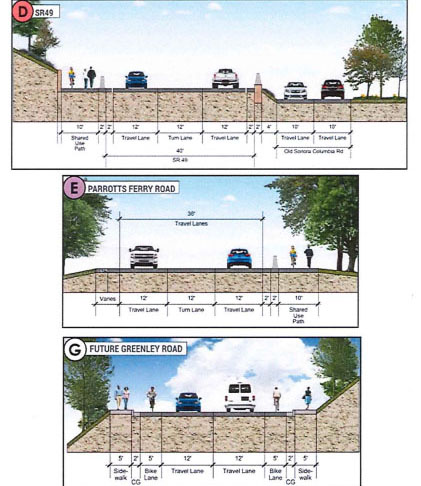Sonora, CA – A nine-mile path that would span from Jamestown through Sonora to Columbia would offer the public a green-friendly mode of transportation.
The proposed Gold Rush Shared Use Path is being called the “backbone of non-motorized travel” in the county by Tuolumne County Transportation Council (TCTC). Executive Director Darin Grossi detailed to Clarke Broadcasting the plan is to get Caltrans to pay for it through the State’s Climate Action Plan for Transportation Investments program. Earlier this month, the TCTC board approved sending a letter of support to Caltrans for the path.
“What we’re asking for is for Caltrans to do a project initiation document that will make it ready to compete for other state discretionary funds,” explained Grossi.

The map in the image box outlines the Gold Rush Shared Use Path project that will utilize current and build new sidewalks and a raised barrier path for walking/biking and other non-motorized vehicles along Highway 49 connecting the three communities. It will also allow for the promoting of electric bicycle usage as a transportation mode, which Grossi shared is an important component of the region’s efforts to reduce automobile emissions.
Noting another benefit to the community, Grossi detailed, “The number one thing is it will address the safety problems we have out on Highway 49. I think we’ve had 68 injury accidents since 2009 and five fatalities, four pedestrians, and one bicyclist. Beyond that, it will provide zero emissions, access to jobs, transit, and higher education at Columbia College.”
TCTC provided this list of additional community needs/benefits addressed by the path:
- Health and Wellness: The Shared Use Path will encourage exercise by connecting disadvantaged residents with nature at Dragoon Gulch, recreation at Rotary Park, Yosemite Regional Transit System stops, and farmers market in Sonora.
- Environment: The Path will reduce emissions in an area that does not attain air quality standards and where many people sensitive to poor air quality currently reside.
- Economic Benefits: Jamestown and Sonora suffer from high unemployment and low household income, the Gold Rush Path will link these disadvantaged communities with Motherlode Job Training, higher education at Columbia College, job centers in Sonora, and the Chicken Ranch Casino Resort.
- Social Equity: This area of the county, containing historically underserved individuals, has not received the benefit of over $140 million in transportation infrastructure investments in the East Sonora/108 corridor where household incomes are higher. Without safe pedestrian/bicycle facilities, low-income residents are disproportionally impacted by the high cost of automobile ownership. This project will provide lower-cost travel options and improve access to public transit.
Grossi sees the path as a win-win for the county and the state, “People end up walking the highway or riding a bike and that’s not safe for them. This will provide a safe alternative. It’s where the state wants to go with its funding towards alternatives that will reduce carbon emissions. We’re working on our calculations on how much the emission will reduce right now. We think the project aligns perfectly with state priorities.”
Currently, the planning level cost of the path is between $9.5 and $20 million. Grossi says that could change if Caltrans takes on the project and does a project initiation document, a cost estimate and schedule for the project. He added, “At that point hopefully that the Caltrans innovative projects team in Sacramento decides it is a high priority and that will put us in a really go position for full state funding.”
The council has not sent out the letter yet as it just completed the funding application this week. Also, currently, they are collecting letters of support from community organizations, which they are still accepting and can be sent to the TCTC office at 2 South Green Street, Sonora 95730.
TCTC is hoping to hear back from Caltrans as early as this spring, but the actual start of the project will be much later with Grossi expecting, “I don’t see it happening any closer than six years and probably ten years, but if you don’t start, you’ll never get it done.”
To view the Gold Rush Shared Use Path presentation, click here.

